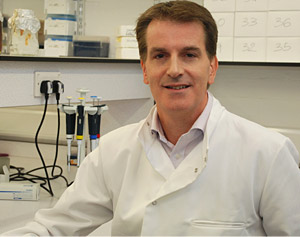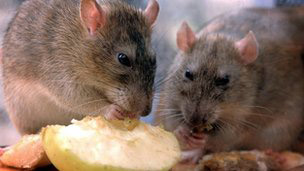Science versus the super rats
Thu, 18 Oct 2012 16:41:00 BST
Dr Dougie Clarke’s nationwide project on the vermin that develop immunity to routine poisons
A UNIVERSITY of Huddersfield scientist has alerted the UK to the mounting problem of ‘super rats’ immune to conventional poison.
But now he is urging local authorities and pest controllers to assist his research by sending samples from dead rats which he and his team can subject to DNA analysis. The true nationwide picture will then emerge.
 Dr Dougie Clarke (pictured right), who is Head of Biological Sciences at the University of Huddersfield’s School of Applied Sciences, leads the UK Rodenticide Resistance Mapping Project. It takes DNA samples from hundreds of rats around the country in order to establish which regions have the highest prevalence of ‘super’ rats that have genetic mutations that protect them from the most commonly used rat poisons.
Dr Dougie Clarke (pictured right), who is Head of Biological Sciences at the University of Huddersfield’s School of Applied Sciences, leads the UK Rodenticide Resistance Mapping Project. It takes DNA samples from hundreds of rats around the country in order to establish which regions have the highest prevalence of ‘super’ rats that have genetic mutations that protect them from the most commonly used rat poisons.
The goal is to find which parts of the country have the largest populations of rats with a genetic resistance to the most commonly used rodenticides – warfarin, bromadiolone and difenacoum. These are anticoagulants that subject rats to death from internal bleeding and have been widely used since the 1950s, but soon after their introduction it was discovered that some rats were unaffected by these poisons.
After it first became known in the 1950s that some rats could withstand conventional poisons, the Government carried out research. But it had to do this by the laborious method of trapping rats and conducting feeding tests on the whole animal. This research was discontinued in the 1990s, but over the past two decades the problem of resistance in rats has increased.
Where the animals thrive they can spread disease, deplete food resources, gnaw electrical cables and even cause structural damage. And because they survived, their descendants have the same resistance. The result, says Dr Clarke, is that while there might have originally been only a few percent of resistant rats in certain urban and rural areas, they now make up a significant proportion of the population.
Highest prevalence in the South of England
The highest prevalence has so far been found in certain areas of South of England and West Country where greater than 70% the animals tested are of the ‘super rat’ type.
This means that populations of the creatures will grow and there could be a threat to wildlife and even domestic cats that hunt and devour rats whose bodies are carrying the poison to which they have become resistant.
 In order to combat the problem there are stronger poisons – such as brodifacoum and flocoumafen – that can be used and they have proved to be effective, even against the so-called super rats. But these rodenticides have to be used in strictly-controlled conditions, under licence from the Health and Safety Executive. Therefore, local authorities, pest control operators and the chemical giants that manufacture the rat poisons need to know which areas of the country are most heavily infested by resistant rats so that the green light can be given to use the more powerful substances.
In order to combat the problem there are stronger poisons – such as brodifacoum and flocoumafen – that can be used and they have proved to be effective, even against the so-called super rats. But these rodenticides have to be used in strictly-controlled conditions, under licence from the Health and Safety Executive. Therefore, local authorities, pest control operators and the chemical giants that manufacture the rat poisons need to know which areas of the country are most heavily infested by resistant rats so that the green light can be given to use the more powerful substances.
“In one area, every rat we analysed was resistant and infestation was so bad that the pest control company applied to the Health and Safety Executive for emergency use of the stronger rodenticides and they were eliminated within two weeks.”
As a result of the discovery of the genetic mutations that cause the resistance, Dr Clarke and his colleagues have embarked on the major new research project, funded by a roster of leading European pest control industry companies (BASF, Bayer, Bell, Killgerm, PelGar, Syngenta), the British Pest Control Organisation and the National Pest Technicians Association. Instead of using live animals the study analyses the animal’s genetic make-up to determine if it is resistant to conventional poisons by using three cms of the tip of a rats tail.
The aim is to test at least 600 animals and it is hoped that the project will be completed in 2013. The arrival of winter weather, robbing rats of much of their natural food supply, will speed up the numbers of samples dispatched to the University of Huddersfield’s labs.
Hot spots in Britain
The focus of the research is on a series of hot spots in Britain where it is known or suspected that the resistant rats predominate. From these focal points, the Rat Resistance Project has devised a series of geographical “transects” which branch out and cover large areas of East Anglia, Avon, the West Midlands, Wales, East Sussex and Kent, the West Midland, plus Cambridgeshire, Nottinghamshire, South Yorkshire and Dumfries and Galloway.
“We’re getting a lot of calls from local authorities, saying ‘Can you do our area?’,” says Dr Clarke. “But we can’t cover the whole country, although we are doing as much of it as the funding allows.”
He hopes that once the current project is completed, a larger, nationwide strategy will follow.
The term ‘super rat’ is quite appropriate, says Dr Clarke. The creatures that are unaffected by routine poisons have not become resistant because of their DNA mutating as a result of their exposure to the rodenticide chemicals. The timescale is too short for that. Instead they have a naturally occuring genetic mutation that protects them from the rodenticide poisons. Over time in an area that is treated with these poisons for rat control with a mixed population of susceptible ‘normal’ rats and the genetically resistant ‘super’ rats the population will become exclusively the ‘super’ rat type that pass the resistance gene to their offspring.
When he has gathered more scientific data, the findings will be published, probably during 2013. But in the interim, news of his research has created nationwide interest, especially in the West of England, where it might be that as many as 75 per cent of rats are the resistant type.
Now Dr Clarke has renewed his appeal for samples. He needs just the tip of a dead rat’s tail killed by trapping, shooting or dogs and is hoping for hundreds more from the regions under survey. Participants who wish to help with the study should contact Dr Clarke by emailing resistancesurvey@hud.ac.uk. They will then be provided a sample kit and full instructions.
The full list of areas covered is:
- Area 1: South West England - Worcestershire, Gloucestershire, Avon, Wiltshire, Oxfordshire
- Area 2: East Anglia - Norfolk, Suffolk, Cambridge
- Area 3: South East England - Kent, East Sussex, West Sussex
- Area 4: Anglo-Welsh Border - Gwynedd, Powys, Staffordshire, Cheshire, Shropshire, Herefordshire, Wrexham
- Area 5: North East England - East Riding, South Yorkshire, Lincolnshire, Nottinghamshire, Rutland
- Area 6: Central Southern England - Berkshire, Hampshire, Surrey
- Area 7: South West Scotland - Dumfries and Galloway







